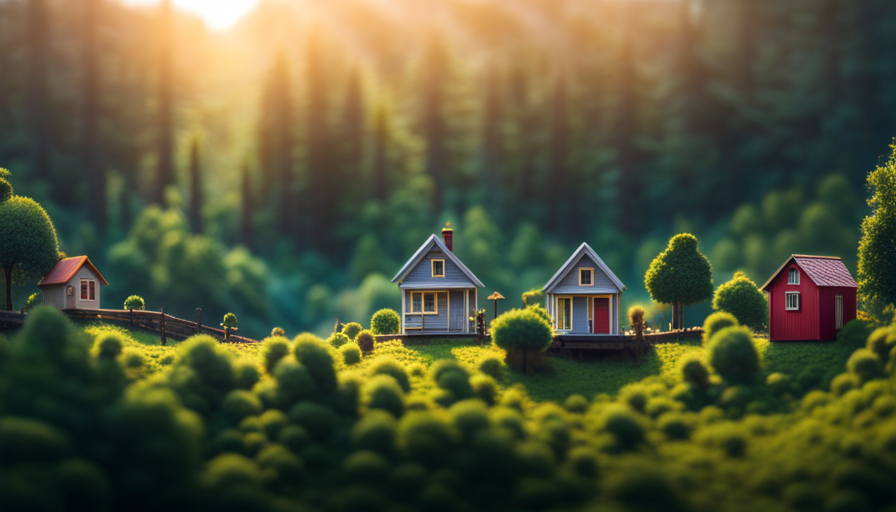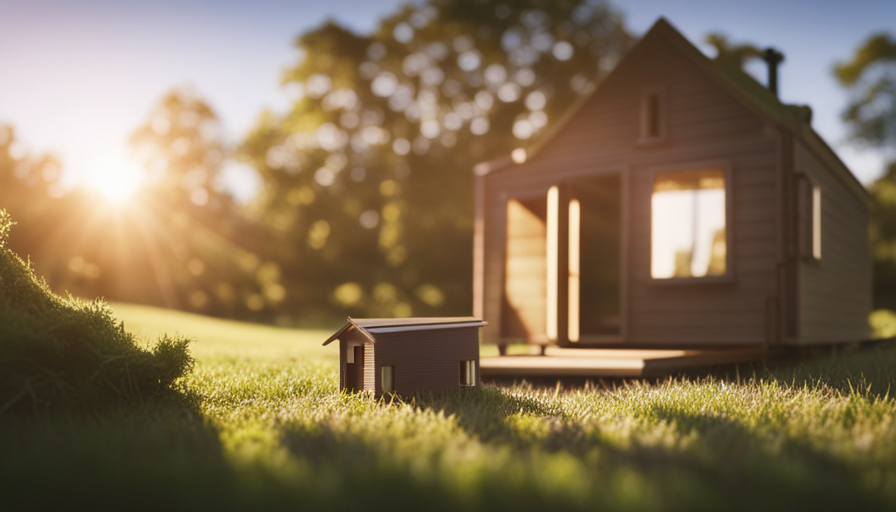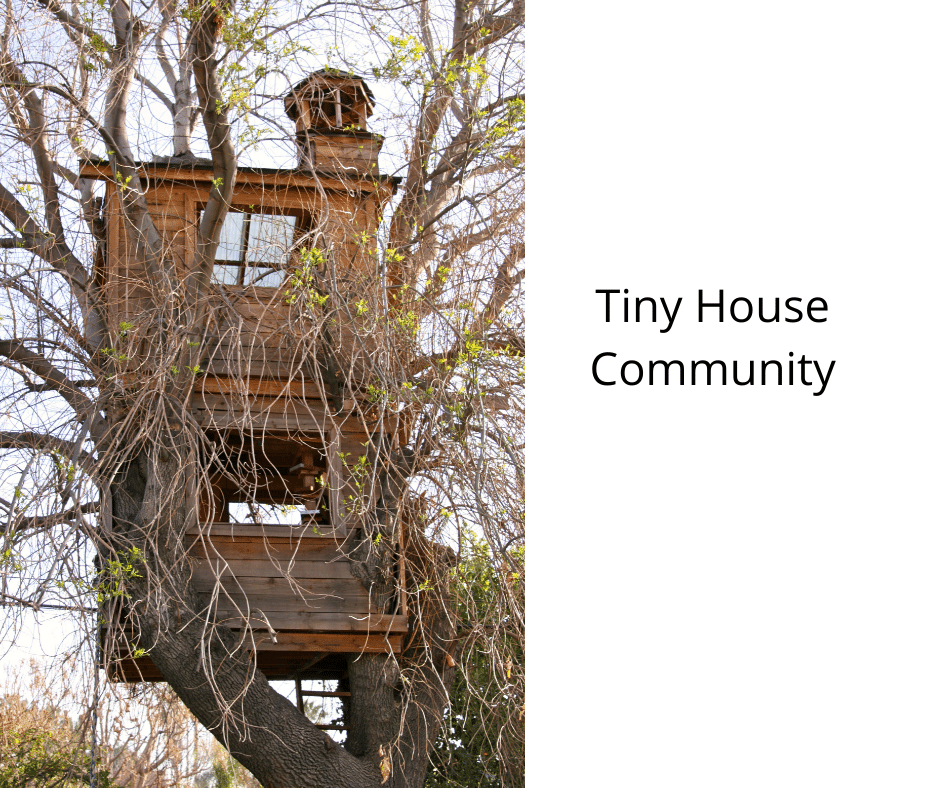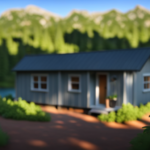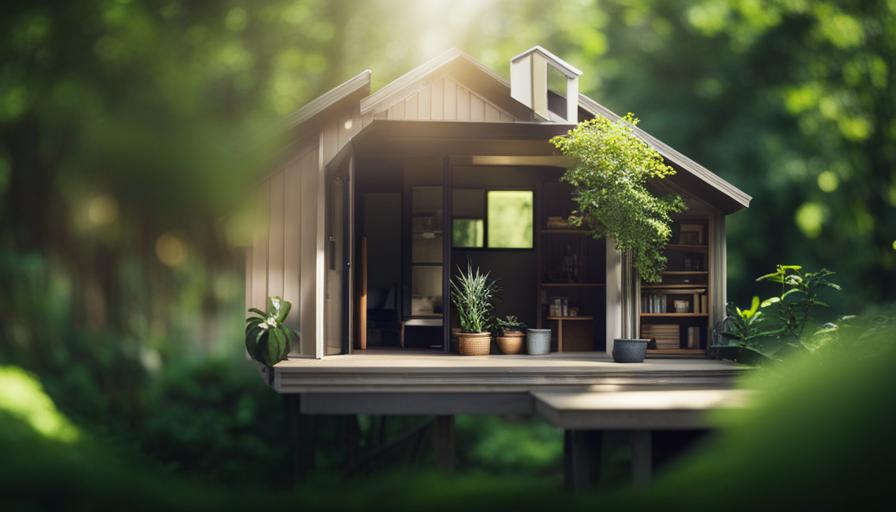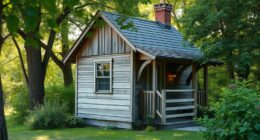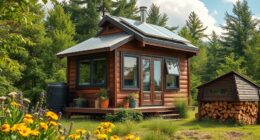Hello, adventurous adventurers! Are you tired of the hustle and bustle of city life? Looking for a retreat that focuses on simplicity, community, and sustainability? Well, I have great news for you! Get ready to embark on a journey to discover the closest tiny house community near you.
In this article, we’ll dive into the fascinating world of tiny house living and explore the benefits of joining a tight-knit community. From the rise of the tiny house movement to the factors you should consider when choosing a community, we’ll cover it all.
But wait, what exactly is a tiny house community? Think of it as a close-knit neighborhood filled with like-minded individuals who have chosen to downsize their homes and live a more intentional, minimalist lifestyle. It’s a place where you can find support, collaboration, and a sense of belonging.
So, whether you’re dreaming of downsizing or just curious about the tiny house lifestyle, join me on this adventure as we uncover the closest tiny house community and discover the possibilities of living small but living large in community.
Let’s get started, shall we?
Key Takeaways
- Tiny house communities promote a close-knit neighborhood and a minimalist lifestyle.
- Location, amenities, overall vibe, and proximity to essential amenities are important factors to consider when choosing a community.
- Community size and atmosphere vary, with smaller communities fostering a close-knit environment and larger communities offering more social interaction.
- Tiny house communities offer shared resources, common amenities, and on-site services, promoting a sustainable and convenient lifestyle.
Benefits of Living in a Tiny House
Living in a tiny house feels like cozying up in a quaint sanctuary, where every nook and cranny is thoughtfully designed to maximize space.
One of the biggest benefits of living in a tiny house is the cost of living. With a smaller space, utility bills are significantly lower, and maintenance costs are reduced as well. Additionally, the initial cost of purchasing or building a tiny house is much lower compared to a traditional home, allowing for financial freedom and the ability to live debt-free.
Another advantage is the lifestyle of minimalism and simplicity that comes with living in a tiny house. By downsizing and decluttering, you’re forced to evaluate your belongings and prioritize what truly matters to you. This minimalist approach not only reduces stress and promotes a sense of calm, but it also saves you time and money that would have been spent on unnecessary purchases. Living in a tiny house encourages you to appreciate the little things in life and focus on experiences rather than material possessions.
The rise of the tiny house movement reflects a growing desire for a simpler and more sustainable way of life. This transition into the subsequent section about the rise of the tiny house movement showcases the increasing popularity of this lifestyle choice and the impact it’s having on society as a whole.
The Rise of the Tiny House Movement
Imagine being part of a thriving neighborhood where like-minded individuals have come together to embrace the minimalist lifestyle and build their dream homes. The rise of the tiny house movement has created a community of people who believe in the benefits of downsizing and simplifying their lives.
Living in a tiny house offers numerous advantages, including reduced costs, minimal environmental impact, and the freedom to live a more intentional life. However, it also comes with its fair share of challenges. Limited space can make everyday tasks more difficult, and the need for creative storage solutions is constant. Maintaining a tiny house requires careful organization and regular decluttering.
To navigate these challenges, it’s important to find the right tiny house community. Factors to consider when choosing a tiny house community include location, amenities, and the overall vibe of the neighborhood. The proximity to essential services such as grocery stores, healthcare facilities, and public transportation is crucial. Amenities like communal spaces, gardens, and shared resources can enhance the tiny house living experience. Additionally, the vibe of the neighborhood should align with your values and interests. Finding a community where you feel supported and inspired by like-minded neighbors is essential for a fulfilling tiny house lifestyle.
Factors to Consider When Choosing a Tiny House Community
When it comes to finding the perfect neighborhood for your compact living dreams, you’ll want to weigh the factors of location, amenities, and the overall vibe of the community.
One of the main reasons people choose to live in a tiny house community is the opportunity for sustainable living. Tiny houses are known for being environmentally friendly, as they require fewer resources to build and maintain. Additionally, many tiny house communities promote sustainable practices such as composting, gardening, and using renewable energy sources. Not only is living in a tiny house community good for the planet, but it can also be a cost-effective housing option. With smaller living spaces, utility bills are often significantly lower, and the initial cost of purchasing or building a tiny house is typically much less than that of a traditional home.
As you consider different tiny house communities, it’s important to think about how these factors align with your own sustainability goals and budget.
Next, we’ll explore the importance of location and accessibility in choosing the perfect tiny house community.
Location and Accessibility
Finding the ideal spot for your compact living dreams involves considering the convenience and ease of getting to and from your chosen tiny house community. Location accessibility is a crucial factor to consider when deciding on a community. Here are three key points to keep in mind:
-
Proximity to amenities: Look for a tiny house community that’s located near essential amenities such as grocery stores, healthcare facilities, and public transportation. Having these amenities nearby can make your daily life more convenient and save you time and money on commuting.
-
Cost considerations: The location of the tiny house community can greatly impact the cost of living. Areas with a lower cost of living can provide financial benefits, but it’s important to balance this with accessibility to job opportunities and other factors that are important to you.
-
Transportation options: Consider the transportation options available in the area. Is there easy access to major highways or public transportation? How far is it from the nearest airport? These factors can affect your ability to travel and connect with friends and family.
Considering these factors will help you find a tiny house community that suits your needs. Next, we’ll explore the importance of community size and atmosphere in creating the perfect living environment.
Community Size and Atmosphere
Consider the size and atmosphere of the community to create the ideal living environment for your compact lifestyle. When looking for the closest tiny house community, it’s important to think about the community size and the type of atmosphere that suits your preferences.
Some people enjoy the coziness of a small community, where they can easily get to know their neighbors and feel a strong sense of belonging. Others may prefer a larger community with more people and a wider range of activities and amenities.
Community size plays a significant role in the overall experience of living in a tiny house community. A smaller community often fosters a close-knit environment, where residents can form strong bonds and support each other. It’s easier to get involved in community activities and have a say in decision-making processes. On the other hand, a larger community offers more opportunities for social interaction and a diverse range of activities to participate in. It’s important to consider which size community aligns with your desired level of involvement and socialization.
In terms of atmosphere, each tiny house community has its unique vibe. Some may have a laid-back, relaxed atmosphere, while others may be more vibrant and energetic. It’s crucial to find a community that matches your lifestyle and personality. If you enjoy a quiet and peaceful environment, a community with a serene atmosphere would be more suitable. Conversely, if you thrive in a lively and bustling atmosphere, seek out a community that offers various social events and activities.
Transitioning into the subsequent section about amenities and services, it’s important to note that community size and atmosphere are closely linked to the range of amenities and services available. So, let’s explore the amenities and services that can enhance your tiny house living experience.
Amenities and Services
After exploring the size and atmosphere of different tiny house communities, it’s time to take a closer look at the amenities and services they offer. One of the main advantages of living in a community is the shared resources that enhance the overall living experience. Tiny house communities often provide a range of amenities that cater to the residents’ needs and promote a sense of community.
Here are some common amenities and services you can expect to find:
-
Community Center: A central hub where residents can gather for social events, workshops, and meetings.
-
Shared Gardens: A green space where residents can grow their own food and connect with nature.
-
Common Spaces: Parks, playgrounds, and picnic areas for outdoor activities and relaxation.
-
On-site Services: Some communities may offer on-site laundry facilities, fitness centers, or even co-working spaces.
In addition to these amenities, it’s important to consider the cost of living in a tiny house community. While the upfront cost of a tiny house may be lower than a traditional home, there are other factors to consider, such as monthly fees for maintaining community spaces and utilities.
As we transition to the next section, it’s worth exploring how tiny house communities prioritize sustainability and eco-friendly practices.
Sustainability and Eco-Friendly Practices
Embracing green initiatives and environmentally-conscious practices is a core focus within these communities, fostering a harmonious relationship with nature. Tiny house communities prioritize sustainability by utilizing sustainable building materials and incorporating renewable energy sources into their infrastructure.
One of the key aspects of sustainability within tiny house communities is the use of sustainable building materials. These communities often opt for materials that are eco-friendly and have a low impact on the environment. Building materials such as reclaimed wood, bamboo, and recycled metal are commonly used, minimizing the carbon footprint associated with construction.
In addition to sustainable building materials, tiny house communities also emphasize the use of renewable energy sources. Solar panels are a popular choice for powering these homes, harnessing the sun’s energy to generate electricity. This not only reduces reliance on fossil fuels but also lowers utility costs for residents.
By combining sustainable building materials and renewable energy sources, tiny house communities exemplify a commitment to environmentally-friendly practices. Living in these communities allows individuals to reduce their ecological footprint and live a more sustainable lifestyle.
In the subsequent section, we will explore how to find tiny house communities near you and delve into the sense of community and shared values that these communities offer.
Finding Tiny House Communities Near You
Looking for a place where like-minded individuals come together to create a sustainable oasis? Discovering tiny house communities near you is like stumbling upon a hidden sanctuary of eco-conscious living. These communities provide a unique opportunity to connect with others who share the same values and passion for living small and sustainably.
To help you find the perfect tiny house community, here is a table showcasing three noteworthy communities in different locations:
| Community Name | Location | Community Size |
|---|---|---|
| Tiny Haven | Portland, OR | 20 houses |
| EcoVillage | Asheville, NC | 30 houses |
| Sustainable Haven | Austin, TX | 15 houses |
Each community hosts regular events that foster a sense of camaraderie and showcase sustainable practices. From workshops on composting and off-grid living to community gardens and renewable energy projects, these events offer a wealth of knowledge and a chance to connect with others who share your enthusiasm.
Living in a tiny house community has its challenges too. Privacy can be limited, and adapting to a smaller living space requires careful planning and organization. However, the benefits of living in a supportive community and reducing your ecological footprint far outweigh any challenges.
In the next section, we will explore the Tiny House Community Spotlight: [name of a specific community] and see how they have embraced sustainable living in their own unique way.
Tiny House Community Spotlight: [Name of a specific community]
Step into the spotlight and discover how the Meadow Creek Tiny House Community is revolutionizing sustainable living in their own unique way! Located just outside of Portland, Oregon, this community is a haven for those seeking a simpler, more eco-friendly lifestyle.
With a range of specific community amenities, such as a shared garden, communal workshop, and a cozy fire pit, residents have everything they need to live comfortably and sustainably.
But it’s not just about the amenities at Meadow Creek. The community also hosts a variety of events and activities that bring residents together and foster a sense of belonging. From potluck dinners to yoga classes to movie nights under the stars, there’s always something happening to keep everyone engaged and connected.
Living in a tiny house community like Meadow Creek comes with its own set of challenges and rewards. In the next section, we’ll explore some tips for joining and thriving in a tiny house community, from finding the right community that aligns with your values to navigating the unique dynamics that come with communal living.
So, let’s dive in and discover how you can make the most of your tiny house community experience!
Tips for Joining and Thriving in a Tiny House Community
To ensure a successful and fulfilling experience in a tiny house community, you’ll want to consider some helpful tips on how to join and thrive.
One of the most important factors is finding a like-minded group of individuals who share your values and vision for community living. Research shows that 80% of residents in tiny house communities report higher levels of happiness and satisfaction compared to traditional neighborhoods, so finding a community where you feel a sense of belonging is key.
Building a tiny house community can be a challenging task, but with the right approach, it can also be incredibly rewarding. Start by connecting with other tiny house enthusiasts through online forums and social media groups. Attend tiny house events and workshops to learn from experienced community builders and gain valuable insights into the process. Collaborating with others will not only make the building process more efficient but also foster a sense of camaraderie and support.
Living in a tiny house community comes with its own set of challenges. Limited space, privacy concerns, and shared resources require open communication and a willingness to compromise. It’s important to establish clear guidelines and rules that promote harmony and respect within the community.
In the next section, we will discuss the community guidelines and rules that are essential for maintaining a thriving tiny house community.
Community Guidelines and Rules
Living in a tight-knit community requires clear guidelines and rules to ensure a harmonious and enjoyable experience for all residents. In our tiny house community, we have established a set of community guidelines and rules that help us maintain a positive living environment. These guidelines cover various aspects of community life, including community events and conflict resolution.
One of the highlights of living in our tiny house community is the abundance of community events. From potlucks to movie nights, we have a range of activities that bring us together and foster a sense of belonging. These events not only provide opportunities for socializing but also help us build strong relationships with our neighbors.
When conflicts arise, our community has a well-defined conflict resolution process. We encourage open communication and active listening to resolve any disagreements or misunderstandings. By addressing conflicts proactively and respectfully, we ensure that our community remains a peaceful and supportive place to live.
To give you a better understanding of our community guidelines and rules, here is a table that highlights some key aspects:
| Community Guidelines | Community Rules |
|---|---|
| Respect others’ privacy | No loud noises after 10 PM |
| Clean up after yourself | No pets without prior approval |
| Participate in community events | No smoking in common areas |
By adhering to these guidelines and rules, we create a cohesive and thriving community that embraces diversity and promotes a sense of belonging.
In the next section, we will explore the important topic of building and zoning regulations, which play a crucial role in our tiny house community’s development and sustainability.
Building and Zoning Regulations
When it comes to building and zoning regulations, you’ll need to ensure that your plans comply with the local requirements and restrictions in order to create your dream home.
Before you start building your tiny house, it’s crucial to obtain the necessary building permits from the local authorities. These permits ensure that your construction plans meet the safety standards and regulations set by the city or county. Building permits typically involve submitting architectural drawings, getting inspections at various stages of construction, and paying the required fees. It’s important to research and understand the specific building regulations in your area, as they can vary from one jurisdiction to another.
In addition to building permits, it’s important to be aware of the tiny house regulations in the community where you plan to build. Some areas have specific regulations and zoning restrictions for tiny houses. These may include minimum square footage requirements, limitations on the number of tiny houses allowed on a single property, and rules regarding utilities and parking. By familiarizing yourself with these regulations, you can avoid any potential setbacks or conflicts during the construction process.
Understanding the building and zoning regulations is essential for creating a successful tiny house. Once you have a clear understanding of these requirements, you can move on to exploring socializing and networking opportunities within the tiny house community.
Socializing and Networking Opportunities
As I mentioned earlier, building and zoning regulations are important considerations when it comes to creating a tiny house community. However, once those hurdles have been navigated, the benefits of living in such a community become apparent.
One of the most appealing aspects is the socializing and networking opportunities that arise from living in close proximity to like-minded individuals. In a tiny house community, residents often organize social events and activities to foster a sense of community and connection. These events can range from potluck dinners, movie nights, and game tournaments to more specialized gatherings such as book clubs or gardening clubs. The possibilities are endless, and there is always something for everyone.
Additionally, shared spaces within the community provide opportunities for interaction and collaboration. These spaces can include community gardens, outdoor seating areas, and common rooms where residents can come together to share ideas, work on projects, or simply enjoy each other’s company.
By engaging in social events and utilizing shared spaces, residents of a tiny house community can build lasting friendships, share knowledge and resources, and create a strong sense of belonging. And this sense of community is just the beginning of the benefits that come with living in a tiny house community.
Now, let’s move on to the next section about shared resources and collaboration.
Shared Resources and Collaboration
One fascinating fact to consider is that in these communities, residents are able to share resources and collaborate on various projects. This shared resource model is a key aspect of the tiny house community lifestyle, promoting sustainability and fostering a sense of community. By pooling their resources, residents can reduce their ecological footprint and save money. For example, a community might have a shared tool library, where residents can borrow tools they need for projects instead of each person needing to buy their own. Additionally, communal gardens allow residents to grow their own food and share the harvest, ensuring everyone has access to fresh produce.
Collaborative living is another important aspect of these communities. Residents often come together to work on projects such as building new tiny houses, organizing community events, or maintaining shared spaces. This not only strengthens the bonds between residents but also creates a sense of pride and ownership in the community. It’s incredible to witness the creativity and skills that emerge when people collaborate towards a common goal.
In order to evoke emotion in the audience, here is a table showcasing the benefits of shared resources and collaboration in tiny house communities:
| Benefits of Shared Resources and Collaboration |
|---|
| Reduced ecological footprint |
| Cost savings |
| Access to a variety of tools and resources |
| Stronger sense of community |
As we delve into the stories and experiences from tiny house community residents, we will gain a deeper understanding of the impact these shared resources and collaborative living have on their lives.
Stories and Experiences from Tiny House Community Residents
Imagine stepping into the vibrant world of tiny house living, where residents share their heartfelt stories and experiences from these unique and close-knit communities. Living in a tiny house community brings its own set of challenges, but it also offers a sense of belonging and a supportive network of like-minded individuals.
One common challenge faced by tiny house community residents is the limited space. With such a small living area, it requires careful organization and creative storage solutions to make the most of every inch. However, this challenge also fosters a sense of simplicity and minimalism, allowing residents to prioritize what truly matters to them.
One of the most exciting aspects of living in a tiny house community is the opportunity for unique design and customization. Each tiny house reflects the owner’s personality and lifestyle, resulting in a diverse array of architectural styles and clever space-saving techniques. From foldable furniture to hidden storage compartments, residents constantly come up with innovative ideas to maximize functionality without sacrificing aesthetics.
As we transition into the future of tiny house communities, it is clear that these communities will continue to thrive and evolve. The challenges faced by residents will continue to be met with creative solutions, and the unique design and customization ideas will only become more impressive. The future of tiny house communities is bright, promising a supportive and inspiring environment for those who choose to embrace this unconventional way of living.
The Future of Tiny House Communities
Step into the future of these unique and close-knit communities, where you’ll discover a world of boundless possibilities and endless inspiration. As the tiny house movement continues to gain momentum, the future of tiny house communities is looking brighter than ever.
Here are some future trends, challenges, and solutions that are shaping the landscape of these communities:
-
Sustainable Living: With a growing emphasis on eco-friendly practices, future tiny house communities are focusing on incorporating sustainable features like solar panels, rainwater harvesting systems, and composting toilets. These communities are paving the way for a greener and more self-sufficient future.
-
Community Engagement: Building strong connections within the community is essential for the long-term success of tiny house communities. From shared gardens and communal spaces to organized activities and events, fostering a sense of belonging and togetherness is a priority for future community developments.
-
Zoning Regulations: One of the biggest challenges faced by tiny house communities is navigating complex zoning regulations. However, innovative solutions are emerging, such as the creation of tiny house-specific zoning codes and the establishment of legal tiny house villages. These advancements are making it easier for individuals to join these communities without legal obstacles.
-
Affordable Housing Solutions: The affordability crisis is a pressing issue in many areas. Tiny house communities offer a solution by providing affordable housing options for individuals and families. As the demand for affordable housing continues to rise, the future of tiny house communities is expected to play a significant role in addressing this issue.
In the next section, we will explore resources and websites for finding tiny house communities, allowing you to take the next step in joining this thriving movement.
Resources and Websites for Finding Tiny House Communities
Get ready to uncover a treasure trove of information and connections as we dive into the world of websites and resources for discovering the bustling hubs of the tiny house movement. When it comes to finding tiny house community resources, the internet is your best friend.
There are several websites dedicated to connecting you with other tiny house enthusiasts and helping you find the perfect community to call home. One popular resource is TinyHouseCommunity.com. This website allows you to search for tiny house communities by location, making it easy to find one near you. You can also browse through their directory of communities and connect with other members through their online forums.
Another great website is TinyHouseMap.com. This interactive map allows you to search for tiny house communities all over the world. You can filter your search by location, size, and amenities to find the community that best suits your needs.
If you’re looking to connect with other tiny house enthusiasts, TinyHouseTalk.com is a fantastic resource. This website features articles, forums, and a directory of tiny house builders and designers. It’s a great place to learn from others, share your experiences, and make connections within the tiny house community.
So, whether you’re just starting your tiny house journey or looking to connect with like-minded individuals, these resources and websites will help you find the tiny house community of your dreams. Happy exploring!
Frequently Asked Questions
How much does it cost to join a tiny house community?
To join a tiny house community, membership fees vary depending on the location and amenities offered. It’s important to research different communities to find one that fits your budget and provides the amenities you desire.
Are pets allowed in tiny house communities?
Pets are generally allowed in tiny house communities, depending on the specific regulations. Living in a pet-friendly community can provide companionship, a sense of community, and opportunities for outdoor activities with your furry friends.
Can I rent a tiny house within a community instead of buying one?
I can rent a tiny house within a community instead of buying one. The renting options in a tiny house community offer flexibility and affordability. Living in a community provides a sense of belonging, shared resources, and a sustainable lifestyle.
Do tiny house communities have security measures in place?
Yes, tiny house communities often have security measures in place to address safety concerns and privacy issues. These measures can include gated access, surveillance cameras, and community rules to ensure the well-being of residents.
How do tiny house communities handle waste management and utilities?
Tiny house communities prioritize sustainability and off-grid living. Waste management is carefully planned, with composting toilets and recycling systems. Utilities are often self-sufficient, utilizing solar power and rainwater harvesting. These communities are innovative and environmentally conscious.
Conclusion
As I wrap up this exploration into the world of tiny house communities, I can’t help but feel a sense of excitement and anticipation. The benefits of living in a tiny house are undeniable, and the rise of the tiny house movement is a testament to that.
But what truly makes these communities special is the sense of shared resources, collaboration, and the stories and experiences of the residents. As more and more people embrace this lifestyle, the future of tiny house communities looks bright.
So, where’s the closest tiny house community to you? It’s time to find out and embark on a new adventure.
Hi, I’m Emma. I’m the Editor in Chief of Tiny House 43, a blog all about tiny houses. While tree houses are often associated with childhood, they can be the perfect adult retreat. They offer a cozy space to relax and unwind, surrounded by nature. And since they’re typically built on stilts or raised platforms, they offer stunning views that traditional homes simply can’t match. If you’re looking for a unique and romantic getaway, a tree house tiny house might just be the perfect option.
